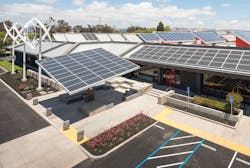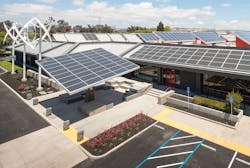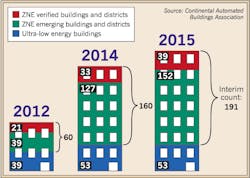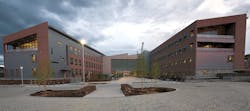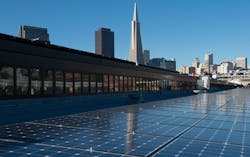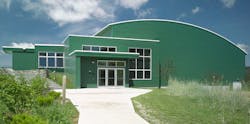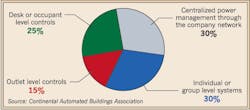There’s a lot of energy — mostly constructive, but some nervous — percolating beneath the mostly placid surface of the zero net energy (ZNE) building movement. It’s still slow to take root, but the inspired concept that envisions pairing aggressive energy conservation techniques with on-site renewable energy to turn energy-devouring beasts into energy-neutral ones may be gathering its second wind.
ZNE advocates appear to be taking stock. They’re trying to chart a course to greater consideration, acceptance, and — they hope — wider deployment. Fueling that confidence is a growing focus on reducing carbon emissions, spreading governmental mandates on building energy usage reductions, and the rise of more affordable and capable alternative energy solutions.
Believers think the case for ZNE is more solid than ever. Estimates that three-quarters of electricity production goes to buildings that account for 40% of carbon emissions offer stark evidence. But ZNE still faces real-world challenges relating to cost, practicality, and reliability.
With an eye to better understanding challenges, efforts have been underway to dissect and evaluate more projects. In total, counting both verified ZNE and those designated as emerging, or prospective ZNE, they now number around 230 in some 40 states, according to a New Buildings Institute (NBI) estimate. In addition, ZNE goals and definitions are being clarified. The hope is that more clarity will foster more realistic approaches to ZNE challenges, and that closer study of different formulas for achieving success will spawn more projects over time.
While it may not be at anything like a crossroads, ZNE does seem to be in the midst of a mild course correction. If so, it’s born more out of qualified successes and abundant promise than widespread failures.
Along with changes in the energy and environmental backdrops that work in ZNE’s favor, the practical aspects of bringing more ZNE buildings online are becoming clearer. That brightening picture, however, could actually be creating conditions for a mild stall for ZNE. Success and promise may actually be feeding uncertainty among proponents and beneficiaries about the best of many viable paths forward.
Ralph DiNola, executive director of NBI, a major force behind ZNE, energetically talks up the concept. Conceding it has hardly attained widespread buy-in, he says new projects have been steadily growing at a predictable pace. According to NBI, deployments have tripled over the last three years, albeit from a low base.
“It’s following the diffusion of innovation curve, moving out of the innovator phase and into the early adopter phase,” he says. “There’s optimism about this moving much more into the mainstream for both commercial buildings and multi-family structures.”
Trouble spots
But there are growing signs that ZNE is facing some headwinds. One is newly documented acknowledgement that many structures built for ZNE aren’t performing optimally, suffering the consequences of inadequate design and planning. The culprits: building control systems and their designers and operators who haven’t been adequately trained in their use.
A recent study done for Continental Automated Buildings Association (CABA) by NBI concluded that most ZNE buildings are hobbled to some degree by systems that don’t work reliably, principally because they weren’t integrated well or with reliable ease of use in mind. Such systems aren’t incidental to ZNE buildings; they’re essential in managing the energy conservation and delivery components that combine to produce a ZNE environment. If they’re not working properly, ZNE can prove hard to attain and maintain.
The CABA study turned on feedback from a cluster of completed ZNE projects. Respondents unanimously agreed that a host of building controls — ranging from lighting systems and HVAC to plug loads and whole building systems — were important factors in getting to ZNE. Moreover, three-quarters said controls were becoming steadily more valuable, even as advancements in design techniques and efficiency technologies contribute more to the process of reducing building energy usage.
The reality, though, is that probably not all controls installations are working out as intended. The study found that only 77% of respondents said they’d select the controls package they deployed again. Boring into that, the study had 82% of designers saying that, generally, control communication platforms and protocols between systems needed improvement, and 87% agreeing “control systems always have some problems.”
Those problems, the study found, generally revolve around ease of use, reliability, and suitability for the project. Users expressed frustration with complex control systems that, among other afflictions, are hard to use, lack interoperability, and don’t come with sufficient post-installation support from parties that designed and installed systems. Too often, the end result is a controls backbone that may hamper efforts to reach ZNE.
As to practical solutions, the study outlines a host of approaches that could form a blueprint for controls that could deliver better ZNE projects in the future. They’re numerous and detailed, turning on the importance of better executing up-front procedures, strategies, and planning. But all seem to point to a need to avoid over-designing, while exercising more care in fully vetting vendors and options.
An engineer with extensive experience designing ZNE projects, Ken Seibert, president of CMTA Consulting Engineers, Louisville, Ky., is all for addressing control systems issues. The challenge, he says, is that ZNE structures have a lot of moving parts that must be carefully orchestrated. Systems must be highly capable, but that doesn’t mean extensively engineered solutions are always the best conductor.
“There are a lot of very complex mechanical control systems out there, but simpler often means better,” Seibert says, noting examples of elaborate systems that have had to be recommissioned due to poor up-front work. “I’m a fan of designing systems that deliver results that can be repeated year after year.”
The balancing act
But as ZNE continues to evolve, more capable systems that also foster building intelligence (i.e., smart buildings) are likely to only assume a more central role. That’s because another emerging trend in the realm of ZNE advocacy is the placement of greater comparative emphasis on the energy conservation side of the ZNE equation.
ZNE can only be achieved with an on-site alternative energy generation component. But there’s growing concern that projects fixate too much on it. Despite many advancements in renewable energy systems, the process of incorporating it into a building remains complex. It’s complicated by matters like payback considerations and a lack of clarity around the all-important matter of utility net metering.
Consequently, ZNE boosters increasingly endorse the approach of putting passive energy savings at the top of the to-do list, pushing out decisions about the energy generation component until later. That approach has effectively helped create a new designation of ZNE-ready buildings, those that get well-situated structurally first, and then later address energy production.
“The important thing is that we know that buildings are ultra-low energy users foremost, so pursue energy efficiency first and drive energy intensity down to the lowest level possible,” DiNola says.
Prioritizing passive strategies in building construction necessarily impacts the nature and scope of any on-site energy component. That’s something Mike Curran, CEO of Red Top Electric, a Livermore, Calif., electrical contractor learned working on a ZNE project in 2013.
Red Top handled the electrical work on the Zero Net Energy Center in San Leandro, Calif. It was a retrofit of an existing building designed to function as a demonstration/net-zero project training facility for members of local IBEW and NECA chapters.
A big up-front focus there was on the on-site renewable energy component. But Curran says it proved to be somewhat of a “cart-before-the-horse” approach. Initial plans, he says, called for heavy reliance on solar to deliver a 300kW system. But further modeling (using energy savings components) reduced the load to 100kW.
“That ended up saving about $1 million by eliminating the need for about half the solar panels, which would have required shoring up the roof,” he says. He also noted that wind turbines incorporated into the renewables mix did not pan out.
His takeaway from that project is that focusing more on the building envelope can pay big dividends in ZNE projects. However, he doesn’t know that for sure, though; since then, he hasn’t taken on any more ZNE projects.
“People are trying to be as green as possible, but they’re covering up their energy use with solar panels,” he says. “In this ZNE model so many other things need to happen. In this project, we focused on minimizing loads before we went to the renewables side to get to zero net.”
Seibert, too, endorses the building-envelope and passive-first approach. In one of his early projects, a school, submeters were initially deployed and uncovered astounding energy waste: 40% of HVAC energy was being vented to the outside, while 23% was lost in the kitchen. IT usage lost another 12%. That knowledge laid the groundwork for building envelope improvements that reduced the alternative energy allocation and led to ZNE certification.
“You need to look at where the energy is going, and come up with strategies to minimize consumption,” he says, ticking off things like building orientation, higher efficiency building systems, energy efficient lighting, daylighting, and better insulation. “It’s not rewarding to put twice as many costly PV panels up on a building than are needed.”
On-site power challenges
But how to integrate solar, and perhaps other emerging renewables, will clearly grow to become a bigger question in future ZNE buildings. With solar technology supply and cost in a state of flux, one advantage of taking a stepped-down, ZNE-ready approach may be to ultimately reap advantages in the form of big breakthroughs still to come in alternative energy systems. It’s a near certainty, though, that as the cost of energy from non-renewable sources almost surely increases over time, investments in on-site generation will pencil out as a winning strategy.
“If the Clean Power Act goes through, and coal ends up being replaced, electric rates will go up,” Seibert says.
As ZNE buildings incorporate on-site power generation, a growing consideration will be how they’re engineered and designed to work in concert with grid-sourced power. Those challenges will become more acute, DiNola says, as systems become more complex and on-site power is merged with that from the grid. That, along with sophisticated control systems, will continue to present new opportunities for electrical engineers and contractors to contribute to workable ZNE solutions.
“We see these buildings as potentially very grid-friendly, and that means a need for things like demand response, distributed energy systems, and storage,” he says. “There’s an important role there in understanding the functionality of the building energy system.”
And that knowledge and expertise must be brought to bear early on in ZNE projects, along with other architectural, engineering, construction, and installation considerations. But many early projects, observers say, have been hobbled by a lack of coordination and collaboration and the lack of an overall, leader-driven project vision.
Strategizing solutions
The CABA study touches on a single, though increasingly important, aspect of that need. Honing in on the importance of a capable, well-designed building controls system it emphasized not only hiring experienced, qualified control systems designers but also involving them in the process at the earliest stage possible. One of its five recommendations was to “integrate the controls contractor,” making them a primary team member from design through occupancy. That helps foster accountability and ensures that all-important controls functionality is addressed on the front, rather than the back end.
From his ZNE experience, as well as expanding work in the building automation arena, Curran is convinced that the complexity of the work and the interconnectivity involved demands close collaboration.
“Once you decide to go down a certain path in these projects, it seems that it takes more focus up-front on pre-construction activities,” he says. “Many times (on the ZNE project), we’d go in a direction that seemed to make sense from an energy renewables/conservation standpoint, but from a price standpoint it didn’t. It’s my sense that you need a very strong team to put up a ZNE building because it’s very much a design-build/design-assist model.”
But while project designers and owners have to be realistic about whether ZNE is achievable given many variables, advocates like NBI are advising more of a “push the envelope approach” orchestrated by a strong project leader. Noting that the CABA study found all respondents agreeing early and clear goal-setting was critical or very important, DiNola goes a step further, saying those goals should also be ambitious and unambiguous.
“We understand not every building or site is appropriate to achieve ZNE, but we think having a target is a very important aspect of reaching that quantum level of performance,” he says. “An absolute target drives the whole process of moving toward that and away from incrementalism. And we know that successful projects often are driven by a champion that usually emerges in the process.”
Barely a decade old as a doable concept, ZNE is still very much in its formative stages. That’s evidenced on many fronts: the U.S. Department of Energy’s release of the first consensus definition of a ZNE building — a bid to rein in run-away interpretations and clear up confusion; new revelations that buildings designed for ZNE struggle to stay in that zone; signs that serious questions linger about whether ZNE buildings are economically feasible; uncertainty about the course of renewable energy.
Yet the bigger picture may prove more decisive, and favorable to ZNE. That’s one in which alarms about climate change and carbon emissions ring louder; energy costs spike higher; energy conservation technologies steadily advance; and larger scale deployment of renewable energy grows more feasible.
The world’s buildings occupy a central place in the debate over how to balance economic growth with environmental sustainability. Continued progress on the ZNE front might go a long way toward determining whether those aims can coexist.
Zind is a freelance writer based in Lee’s Summit, Mo. He can be reached at [email protected].
SIDEBAR: Zero Net Remains in a Class by Itself
Building codes have helped moved the needle on building energy efficiency, but it’s unlikely they’ll be a major driver for zero net energy (ZNE) buildings.
The 2015 International Energy Conservation Code, for instance, continues a multi-cycle ratcheting up of prescriptions for boosting building energy efficiency via an array of building envelope-fortification approaches. But according to Ryan Meres, who monitors the IECC for the Institute for Market Transformation, the code isn’t nearly strict enough to use as a template for a ZNE building.
“If you build to the 2015 [IEC] code, you wouldn’t get to ZNE unless you had an insane amount of renewable energy,” says Meres, senior code compliance specialist. “The least energy efficient you can build by law is the goal, and it’s a steppingstone to net zero, but you’d need a 30% to 50% improvement in efficiency above the IECC to get to net zero.”
And while there’s been a 30% increase in stringency in the IECC since 2006, Meres says that pace isn’t likely to continue. “There will continue to be some efficiency gains, but not at the magnitude we saw, especially between 2009 and 2012.”
The reason for the slowdown is partly because the code’s prescriptive approach is coming up against a wall, Meres says. The incremental efficiency gains from doing specific things are becoming smaller.
That may set the stage for a subtle change in approach, moving away from being a prescriptive document to more of an overall performance-focused one that is more fluid. And that, he says, is more in line with the approach taken in designing ZNE buildings.
“As we move toward ZNE, that’s where the code needs to head, away from being a prescriptive and strict one and toward a simpler one that allows for more cost-conscious design flexibility and the establishment of targets for overall energy consumption,” he says.
While the IECC continues to evolve, other codes governing building energy consumption could also impact the course of building energy efficiency, and perhaps ZNE’s pace of development. In fact, Meres sees ASHRAE 1891.1, “Standards for the Design of High-Performance Green Buildings” and ASHRAE 90.1, “Energy Standards for Buildings Except Low Rise Residential Buildings,” as being candidates for a merging that would have the effect of elevating building energy efficiency standards to a much higher level.
About the Author
Tom Zind
Freelance Writer
Zind is a freelance writer based in Lee’s Summit, Mo. He can be reached at [email protected].
